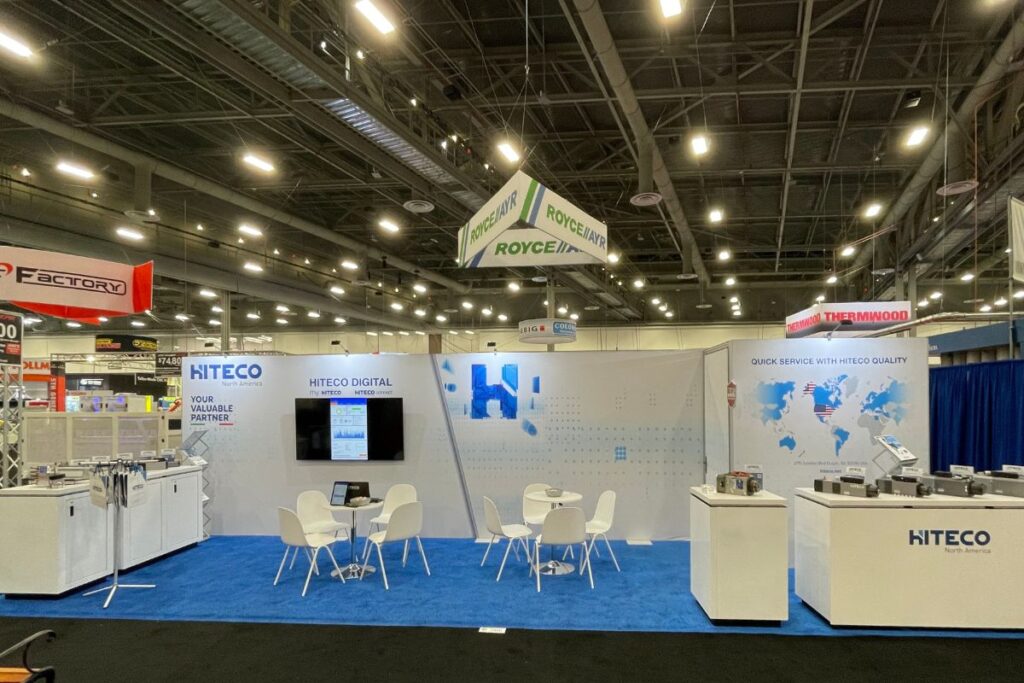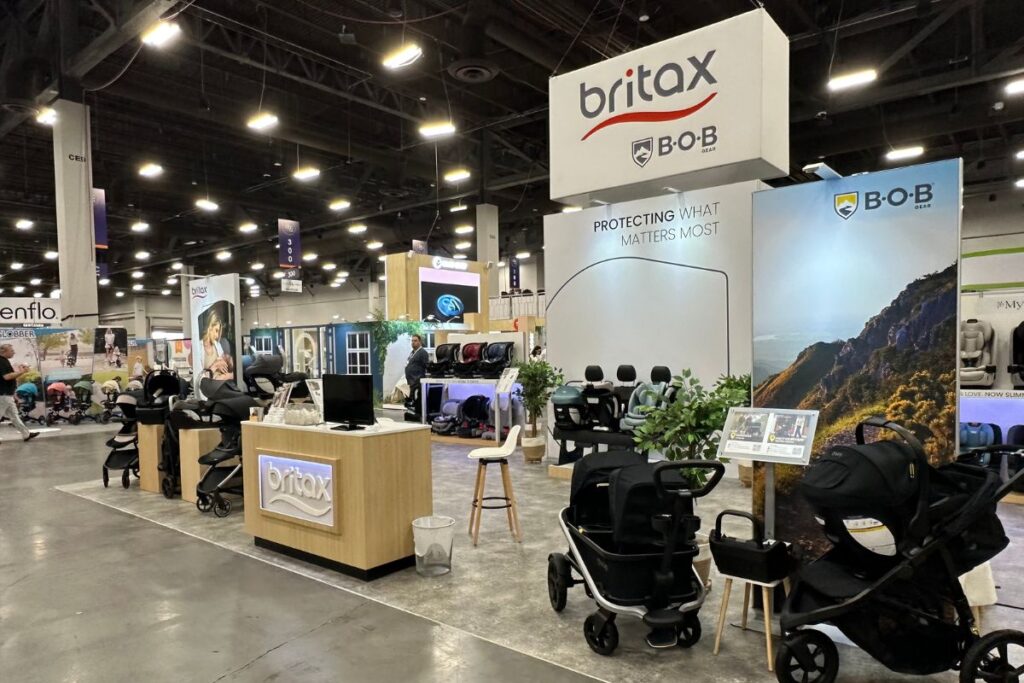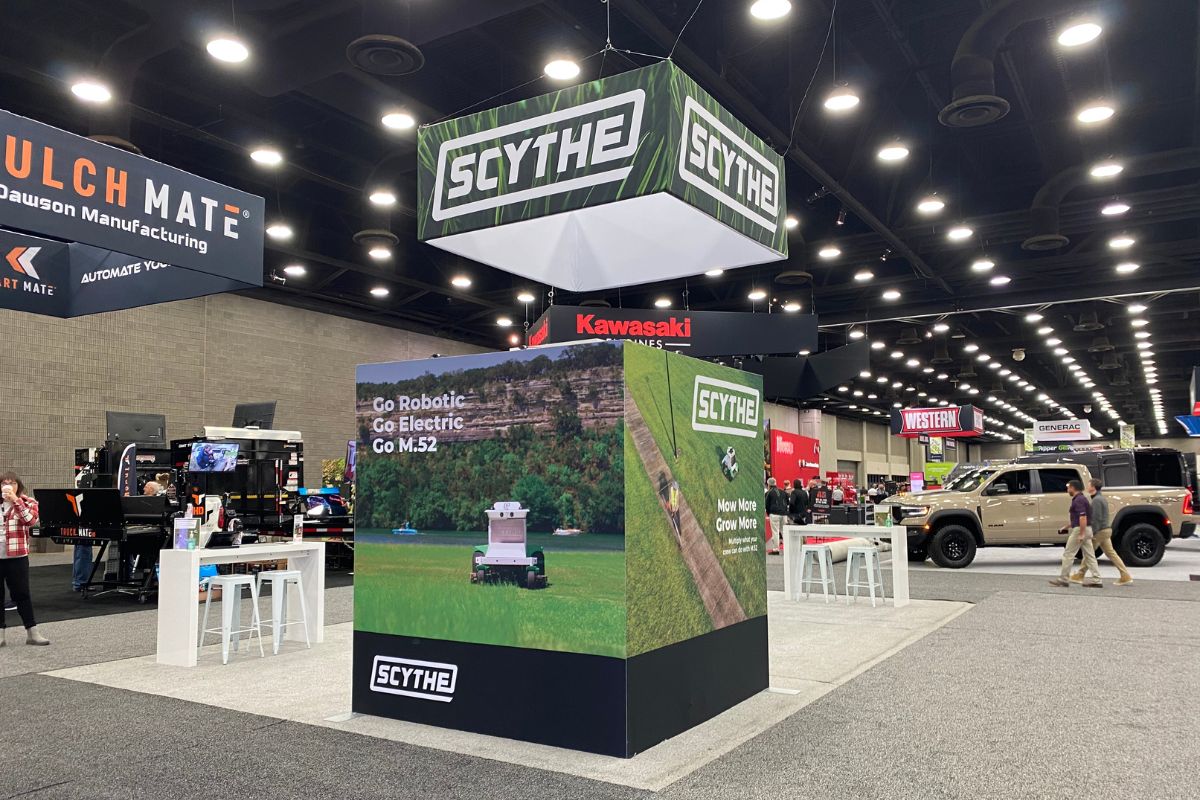You’re standing in your CEO’s office three weeks after the trade show, explaining why your $75,000 conventional booth generated exactly twelve lukewarm leads. We’ve been in that uncomfortable chair ourselves, watching marketing VPs shuffle through disappointing post-show reports while their CFO raises an eyebrow at the ROI numbers.
Here’s what we learned the hard way—most companies blow their trade show budget on the wrong stuff. They chase shiny objects and Instagram-worthy booth designs instead of focusing on the nuts-and-bolts elements that actually get trade show attendees to stop, engage, and eventually sign contracts.
After twenty years of setting up exhibits for companies you’d recognize (think Fortune 500 logos on glass towers), we’ve figured out the difference between convention booth must-haves that work and expensive mistakes that look pretty in photos but fall flat when it comes to measurable business growth.
The Strategic Foundation Every Convention Booth Needs
Brand Recognition That Stops Traffic Cold
Your exhibition booth has about as much time as a TikTok video—8 seconds—to grab a busy executive’s attention as they power-walk past your booth space with their third espresso of the day. That’s barely enough time to read a text message, let alone process complex messaging.
The booth designs that consistently make people stop mid-stride and actually approach? They nail three things that most companies completely mess up: company branding you can read while squinting from across a crowded trade show floor, a value proposition that makes sense even when someone’s brain is fried from information overload, and visuals that immediately scream “these people actually get what we do.”
Take our manufacturing client who was getting ignored at IMTS year after year. We ditched their corporate brochure approach and instead showcased exploded views of their machinery—suddenly engineers were practically pressing their noses against the booth walls trying to see the internal components. Meanwhile, a fintech company we worked with was drowning in a sea of generic “solutions” messaging until we put up clean dashboards showing actual customer ROI numbers. Boom—CFOs started lining up.
Here’s the thing: your booth setup needs to answer the question “What’s in it for me?” before people even think about approaching your booth. And yes, that includes everything from your custom tablecloth (which most people treat as an afterthought) to your booth walls (which should tell a story, not just display logos).
Key brand awareness elements include:
- Custom tablecloth reinforcing corporate colors and messaging
- Booth walls creating cohesive visual storytelling
- Promotional products strategically positioned for your target audience
- Interactive displays showcasing core capabilities
Technology Integration That Actually Converts
We’ve watched more tech demos crash and burn than a NASCAR highlight reel. Here’s what usually happens: Day one, everything works perfectly. Day two, the WiFi starts acting up. Day three, your $15,000 interactive display is basically an expensive paperweight while potential customers awkwardly shuffle past your booth visitor area.
The companies that actually nail interactive elements? They think like engineers, not marketers. Take this logistics company we worked with—instead of some fancy AR nonsense that would inevitably break, they set up simple screens showing real package tracking in real-time. Suddenly, logistics managers were gathering around asking, “How the heck are you doing that?”
Or consider our manufacturing client who skipped the VR headsets (thank goodness) and went with basic tablets loaded with product configurators. Booth visitors could actually build custom solutions on the spot, and our client’s sales team could immediately quote pricing. No gimmicks, no crashes, just practical interactive experiences that led to actual conversations about actual deals.
The bottom line? Your trade show exhibit technology should either show off what you can do, capture real lead information, or help your sales team have better conversations with potential customers. If it’s just there to look cool, you’re throwing money at the wrong problem.
Proven interactive element strategies:
- Product demonstration stations with hands-on experiences
- Digital displays showcasing customer success stories
- Photo booth integration for social media amplification
- Interactive display walls featuring customizable solutions

Essential Infrastructure for Professional Operations
Lead Management Systems That Actually Work
Let’s talk about the nightmare that haunts every marketing VP’s sleep: It’s Monday morning after the trade show, and you’ve got a spreadsheet with 247 “leads” that your sales team will definitely, absolutely ignore because half of them are college kids who wanted free pens and the other half are your competitors doing reconnaissance.
Your conventional booth needs systems that separate the wheat from the chaff without making your already-overworked sales team hate you. The setup that actually works? Think of it like airport security—multiple checkpoints for different types of people.
Quick badge scans for the tire-kickers and curiosity seekers. Detailed forms for people who are actually in buying mode. And here’s the secret sauce—notification systems that ping your senior people immediately when someone important shows interest. Because when the VP of Operations from a $500 million company wants to chat about your solution, you don’t want to find out about it three weeks later buried in a CRM report.
The smartest companies we work with carve out actual meeting spaces within their booth space. Picture this: You’re talking million-dollar deals with a C-suite executive, and Karen from accounting two booths over is loudly explaining her company’s 401k benefits. Not exactly the vibe you’re going for, right?
Storage and Event Planning Excellence
Here’s something nobody talks about until it’s too late: where the heck do you put everything? We’ve seen $100,000 booth designs that look amazing in renderings but turn into complete chaos because nobody thought about storage.
Your booth space needs to handle the reality of trade show life—demo equipment that costs more than most people’s cars, promotional materials that multiply like rabbits, staff who need somewhere to eat lunch without looking like they’re having a picnic, and all the random stuff that accumulates during a four-day show.
Smart event planning starts with the unglamorous stuff. Where does your expensive interactive display go overnight? (Hint: not locked in your rental car.) How do you keep your marketing materials from looking like they survived a tornado? Where can your booth staff take five minutes to decompress without destroying the professional atmosphere you’ve spent months creating?
Our clients who nail this reduce their operational headaches—and costs—by about 25%. It’s not sexy, but when your custom exhibits include actual thought about real-world logistics, everything else runs smoother.
Your custom exhibits should include designated areas for giveaways and promotional items that don’t interfere with primary interactive experience zones or compromise overall brand visibility.
Maximizing ROI Through Strategic Booth Ideas
Design Elements That Drive Business Conversations
The best trade show booth ideas work like a good party—they guide people naturally through the experience without making it feel forced or weird. Your trade show display should have a flow that makes sense, taking visitors from “Oh, what’s this?” to “Tell me more” to “How do we get started?”
We recently worked with a tech client getting ready for CES who had fallen into the classic trap—they wanted to show everything they did all at once. Their booth looked like a technology museum exploded. So we stripped it back and created zones: an attention-grabbing interactive display near the aisle, demo stations for deeper conversations, and a quiet corner for serious business discussions.
The result? Instead of overwhelming people with options, we guided them through a logical journey. First-time visitors could get the big picture, interested prospects could dive deeper, and qualified leads could have real conversations. Leads increased by 40% because people actually understood what the company did instead of wandering around confused.
Your custom tablecloth, booth walls, promotional items—they all need to work together like a symphony orchestra, not compete for attention like a middle school talent show.
Promotional Strategy Integration
Let’s be honest about promotional products—most companies get this spectacularly wrong. They either go full Vegas casino with branded stress balls and miniature flashlights, or they go so premium that they’re basically giving away iPad minis to anyone with a pulse.
The sweet spot? Give people something they’ll actually use that also happens to remind them of your company. We’ve seen remarkable results when clients ditch the random swag approach and instead think strategically about their target audience’s daily challenges.
One client started giving away really nice insulated coffee mugs at manufacturing trade shows. Sounds simple, right? But here’s the thing—plant managers and engineers drink coffee constantly, and every time they used that mug over the next year, they saw the company logo. Compare that to the branded stress ball that gets thrown in a junk drawer and forgotten by Thursday.
Your marketing materials and giveaways should extend your trade show experience long after everyone goes home. When done right, your promotional items become subtle salespeople working for you months after the trade show floor gets packed up.

Staffing Your Exhibition Booth for Maximum Impact
Your booth staff can make or break the entire experience, and we’ve seen both extremes. On one end, you’ve got the overeager sales rep who pounces on everyone like a golden retriever meeting new people. On the other end, you’ve got the technical expert who knows everything about the product but explains it like they’re defending a PhD dissertation.
The people working your conventional booth need to be professional ambassadors who can read the room. When a senior executive approaches your trade show exhibit, they don’t want to chat with someone who’s going to waste their time with basic questions they could have answered with a five-minute Google search.
We train our clients’ teams to spot the difference between someone who’s just browsing and someone who’s actually evaluating solutions. The browsers get friendly hellos and maybe some marketing materials. The serious prospects get conversations with people who can talk strategy, ROI, and implementation timelines.
Here’s what works: Staff your booth with people who can match the seniority level of your target audience. VPs want to talk to VPs. Engineers want to talk to engineers. CFOs want to talk to people who understand P&L statements, not just product features.
Effective attendee engagement strategies include:
- Staff members who can quickly identify qualified prospects
- Demonstration specialists showcasing your interactive experience offerings
- Senior representatives authorized to discuss partnerships and custom solutions
- Follow-up coordinators ensuring leads receive immediate post-show attention
Proven Results from Strategic Implementation
Look, we could throw around statistics all day about trade show ROI and conversion rates, but here’s what actually matters: When you get this stuff right, you’ll know it. Your sales team will stop rolling their eyes at trade show leads. Your CFO will stop questioning the budget allocation. And you’ll stop having those awkward post-show meetings where everyone pretends the numbers were “really quite good, considering.”
We recently managed a complete booth overhaul for a manufacturing client who was attending five major industry shows per year. Their previous approach was basically throwing money at the problem—bigger booths, fancier displays, more promotional products. But they were still struggling with lead quality and follow-up.
So we stripped everything back to basics. Better booth setup processes that actually made sense. Interactive elements that solved real problems instead of just looking impressive. Promotional materials that their target audience would actually want. Staff training that focused on having meaningful conversations instead of collecting business cards.
The results? Sixty percent higher attendee engagement across all their shows, and—here’s the number that made their CEO smile—45% more qualified leads that actually turned into sales conversations.
Your exhibition booth isn’t just display space. It’s a complete business system where every piece needs to work together: your custom tablecloth, booth walls, interactive displays, promotional products, and especially the people running the whole operation.

Partner with Exhibition Experts Who Deliver Enterprise Results
Building a trade show display that actually drives business results isn’t something you can wing with good intentions and a healthy budget. It requires strategic thinking, experience with what actually works (versus what looks good in theory), and flawless execution across a dozen different moving parts.
At Brave Exhibits, we’ve spent two decades helping companies you’d recognize transform their trade show presence from expensive networking events into genuine business development engines. We’re based in Denver, but we work with enterprise brands nationwide who are tired of mediocre results and ready to treat their trade show investment like the serious business strategy it should be.
Whether you need fresh booth ideas that actually make sense for your industry, custom tablecloth designs that reinforce your brand, interactive display development that won’t crash on day two, or complete trade show booth design services that coordinate everything from logistics to lead management, we’ve got the experience to make it happen.
We understand the unique pressures facing VPs of Marketing and Events at mid-to-large companies. You need results that justify the budget, experiences that impress your target audience, and systems that make your job easier instead of more complicated.
Ready to stop treating trade shows like necessary evils and start using them as competitive advantages? Let’s talk about how we can help you create a conventional booth that delivers the kind of ROI numbers that make everyone happy—including your CEO.


